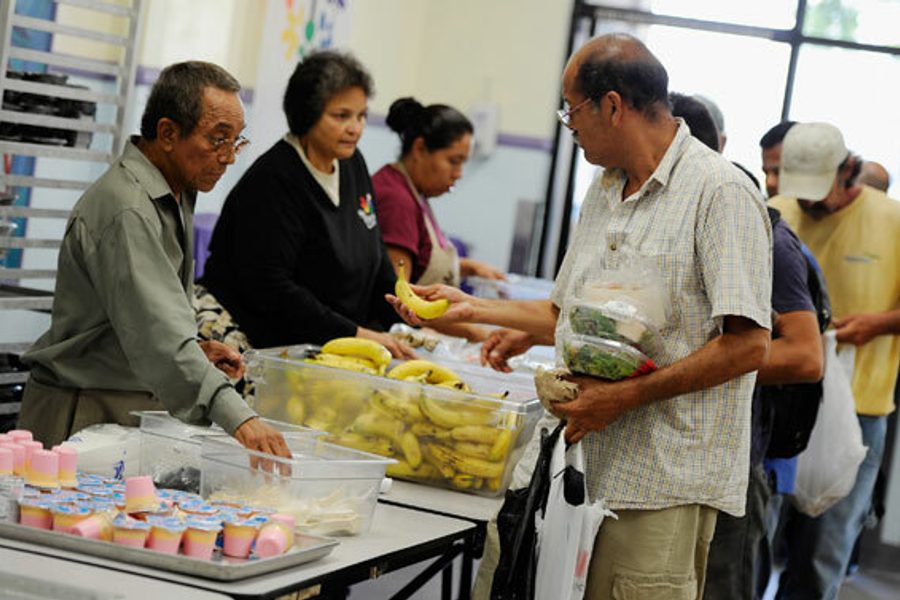
The news in Tuesday’s Census report on income and poverty in the United States was “grim,” Center on Budget and Policy Priorities president Robert Greenstein said bluntly. There was little room for argument:
- From 2009 to 2010 the official poverty rate rose sharply (up 0.8 percentage points to 15.1 percent, the highest rate since the U.S. was exiting recession in 1993). Since the recession started, 8.9 million more Americans have slipped into poverty.
- Out of the 46.2 million people with incomes below poverty ($22,300 for a family of four), 20.5 million lived in “deep poverty,” less than half the poverty threshold — the highest rate since records started in 1975.
- Median household income — income at the midpoint of all households — dropped 2.3 percent in real, inflation-adjusted dollars to $49,445. (And it has declined 6.4 percent since 2007 when the Great Recession began.)
- The number of people without health insurance rose to 49.9 million (though there was no significant change in the percentage uninsured, about one in six).
But there are two important qualifiers that help put these numbers in perspective.
First, this widespread, deep downturn in families’ economic fortunes is predictable after such a deep, prolonged recession compounded by its roots in financial crises and a bursting housing bubble. But it is especially painful because it follows what many are calling a “lost decade” for the majority of Americans. The median household income peaked in 1999 at $53,252, then dropped in most of the following years, never recovering its pre-recession high. Likewise, even during the recovery of the Bush years, poverty levels crept upwards. The big exception was the very rich, who captured most of the new income generated as productivity of the economy rose and inequality continued to grow.
“The typical American family has experienced no real improvement in income in the last 14 years, a nearly unprecedented stagnation, during a period of productivity growth, technological innovation and rapid global economic integration,” AFL-CIO president Richard Trumka said.
Second, bad as these numbers are, they would have been much worse if many government programs and policies had not been in place. Unemployment insurance — whose extensions expire at the end of the year — kept 3.2 million people out of poverty in 2010. The Earned Income Tax Credit helped lift 5.4 million more out of poverty, and food stamps (SNAP) saved 3.9 million. The Obama administration’s stimulus programs (American Recovery and Reinvestment Act) lowered the unemployment rate by as much as 1.8 points and increased the number of full-time-equivalent jobs by as much as 4.8 million compared with what would have happened without it.
The record on health insurance was also better than it would have been, taking into account the erosion of employer-based health insurance, without two new or expanded government policies. First, even though 3.4 million children lost employer-based coverage, the number of children with health insurance grew by 577,000 from 2007 to 2010 as a result of expansion of and aggressive enrollment of children in the federally established State Children’s Health Insurance Programs. And most likely as a result of the Affordable Care Act’s requirement that insurers cover adult dependent children until age 26, adults age 19 to 25 were the only group of non-elderly adults who actually were more fully insured in 2010 than in 2009.
State and local programs also cushioned the recession’s blows, but Temporary Aid to Needy Families (which replaced Aid to Families with Dependent Children, AFDC) provides much less help than the earlier “welfare” programs. In 1979, 82 percent of families below poverty got some direct cash assistance and 68 percent in 1986, Greenstein says, but only 27 percent in 2009 received such aid.
The right-wing Heritage Foundation typically minimized what poverty means in America, which has a higher poverty rate than all but three of 34 developed or industrializing countries studied by the Organization for Economic Cooperation and Development. It pointed to the number of poor households with air conditioning (perhaps a single old window unit in a sweltering Southern city) or a television (hardly a luxury item). It ignored CBPP findings that poor families with children experience much greater hardship than those at or above twice the poverty line: 7 times as likely to experience hunger, 5 times more likely to live in overcrowded housing (a rapidly growing problem in this housing-bust recession), 6 times as likely to be late in paying rent or a mortgage.
“There is no relief in sight,” warns Economic Policy Institute analyst Heidi Shierholz, with unemployment expected to remain high for several years. And as the National Employment Law Project reports, the new jobs being generated are disproportionately lower-wage. That will further erode the middle class, which has been receiving a declining share of national income, reports Center for American Progress analyst David Madland, as the rich continue to benefit at the expense of everyone else, even as they also experience some financial rough weather.
There are warning signals of even deeper misery, poverty and declining income as both state and federal governments adopt austerity policies and many of the cushions that softened the hard fall in the recession are pulled away.
“For a generation, Americans were told that if we lowered taxes on the rich and dismantled rules and regulations, we would have more and better jobs for everyone,” Trumka said. “We need to end this economic experiment gone wrong before the American dream is left behind for good.”
David Moberg, a former senior editor of In These Times, was on staff with the magazine from when it began publishing in 1976 until his passing in July 2022. Before joining In These Times, he completed his work for a Ph.D. in anthropology at the University of Chicago and worked for Newsweek. He received fellowships from the John D. and Catherine T. MacArthur Foundation and the Nation Institute for research on the new global economy.








